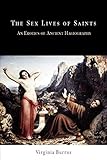The Sex Lives of Saints : An Erotics of Ancient Hagiography / Virginia Burrus.
Material type: TextSeries: Divinations: Rereading Late Ancient ReligionPublisher: Philadelphia : University of Pennsylvania Press, [2010]Copyright date: ©2004Description: 1 online resource (224 p.)Content type:
TextSeries: Divinations: Rereading Late Ancient ReligionPublisher: Philadelphia : University of Pennsylvania Press, [2010]Copyright date: ©2004Description: 1 online resource (224 p.)Content type: - 9780812220209
- 9780812200720
- 261.8/357 21
- BT708 .B885 2004eb
- online - DeGruyter
- Issued also in print.
| Item type | Current library | Call number | URL | Status | Notes | Barcode | |
|---|---|---|---|---|---|---|---|
 eBook
eBook
|
Biblioteca "Angelicum" Pont. Univ. S.Tommaso d'Aquino Nuvola online | online - DeGruyter (Browse shelf(Opens below)) | Online access | Not for loan (Accesso limitato) | Accesso per gli utenti autorizzati / Access for authorized users | (dgr)9780812200720 |
Browsing Biblioteca "Angelicum" Pont. Univ. S.Tommaso d'Aquino shelves, Shelving location: Nuvola online Close shelf browser (Hides shelf browser)

|

|

|

|

|

|

|
||
| online - DeGruyter Transatlantic Insurrections : British Culture and the Formation of American Literature, 173-186 / | online - DeGruyter The Promised Lands : The Low Countries Under Burgundian Rule, 1369-1530 / | online - DeGruyter The Arabic Role in Medieval Literary History : A Forgotten Heritage / | online - DeGruyter The Sex Lives of Saints : An Erotics of Ancient Hagiography / | online - DeGruyter Fallen Bodies : Pollution, Sexuality, and Demonology in the Middle Ages / | online - DeGruyter The Fantasy Factory : An Insider's View of the Phone Sex Industry / | online - DeGruyter Beverly Hills, 90210 : Television, Gender, and Identity / |
Frontmatter -- Contents -- Introduction: Hagiography and the History of Sexuality -- Chapter 1. Fancying Hermits: Sublimation and the Arts of Romance -- Chapter 2. Dying for a Life: Martyrdom, Masochism, and Female (Auto)Biography -- Chapter 3. Hybrid Desire: Empire, Sadism, and the Soldier Saint -- Chapter 4. Secrets of Seduction: The Lives of Holy Harlots -- Postscript (Catching My Breath) -- Notes -- Bibliography -- Index -- Acknowledgments
restricted access online access with authorization star
http://purl.org/coar/access_right/c_16ec
Has a repressive morality been the primary contribution of Christianity to the history of sexuality? The ascetic concerns that pervade ancient Christian texts would seem to support such a common assumption. Focusing on hagiographical literature, Virginia Burrus pursues a fresh path of interpretation, arguing that the early accounts of the lives of saints are not antierotic but rather convey a sublimely transgressive "countereroticism" that resists the marital, procreative ethic of sexuality found in other strands of Christian tradition.Without reducing the erotics of ancient hagiography to a single formula, The Sex Lives of Saints frames the broad historical, theological, and theoretical issues at stake in such a revisionist interpretation of ascetic eroticism, with particular reference to the work of Michel Foucault and Georges Bataille, David Halperin and Geoffrey Harpham, Leo Bersani and Jean Baudrillard. Burrus subsequently proceeds through close, performative readings of the earliest Lives of Saints, mostly dating to the late fourth and early fifth centuries-Jerome's Lives of Paul, Malchus, Hilarion, and Paula; Gregory of Nyssa's Life of Macrina; Augustine's portrait of Monica; Sulpicius Severus's Life of Martin; and the slightly later Lives of so-called harlot saints. Queer, s/m, and postcolonial theories are among the contemporary discourses that prove intriguingly resonant with an ancient art of "saintly" loving that remains, in Burrus's reading, promisingly mobile, diverse, and open-ended.
Issued also in print.
Mode of access: Internet via World Wide Web.
In English.
Description based on online resource; title from PDF title page (publisher's Web site, viewed 24. Apr 2022)


